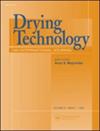Advancements in salbutamol sulphate formulation: Spray-drying technique for the production of porous particles with enhanced properties for inhalation drug delivery
IF 2.7
3区 工程技术
Q3 ENGINEERING, CHEMICAL
引用次数: 0
Abstract
AbstractA fast, simple and cost-effective technique has been used to produce spray-drying porous particles of salbutamol sulfate (SS) for inhalation drug delivery. The particles were produced using water as solvent and ammonium bicarbonate as pore-forming agent. A full factorial experimental design (24) with a central point was used to evaluate the influence of process parameters (drying air inlet temperature, atomization air volume flowrate, feed volume flowrate and the pore-forming agent concentration) on process yield, moisture content, densities and particle size. In addition, particle morphology, in-vitro aerosolization properties, stability and cytotoxicity of selected samples were studied. Within the experimental design parameters window, it was shown that the highest inlet temperature and pore-forming agent concentration were the factors that more affected the process yield and tap density values. Particles with the lowest tap densities values exhibited porous morphology. In addition, the pore-forming agent concentration proved to be the most significant variable affecting particle size. The highest pore-forming agent concentration, the largest particle size. The porous particles exhibit remarkable aerosolization performance, surpassing the performance of previously reported SS porous particles and a commercial formulation. These powders showed a high process yield and the absence of ammonium bicarbonate in the final product, as confirmed by FT-IR. Furthermore, the powders presented good stability even over long periods of time and did not exhibit cytotoxicity on the murine alveolar macrophage cell line RAW 264.7.Keywords: Porous particlessalbutamol sulfatespray dryingammonium bicarbonate Disclosure statementThe authors declare that they have no known competing financial interests or personal relationships that could have appeared to influence the work reported in this paper.Additional informationFundingThe authors thank the financial support from Consejo Nacional de Investigaciones Científicas y Técnicas (CONICET) [grant number: PIP 11220150100704CO] and Universidad Nacional del Sur (UNS) of Argentina [grant number: PGI 24M/163].硫酸沙丁胺醇制剂的进展:用于生产多孔颗粒的喷雾干燥技术,增强了吸入药物输送的性能
摘要采用一种快速、简单、经济的方法制备了用于吸入给药的硫酸沙丁胺醇喷雾干燥多孔颗粒。以水为溶剂,碳酸氢铵为成孔剂制备颗粒。采用具有中心点的全因子实验设计(24)来评估工艺参数(干燥空气入口温度、雾化空气体积流量、进料体积流量和成孔剂浓度)对工艺产量、水分含量、密度和粒度的影响。此外,还研究了所选样品的颗粒形态、体外雾化性能、稳定性和细胞毒性。在实验设计参数窗口内,最高入口温度和成孔剂浓度是影响工艺产率和丝锥密度值的主要因素。轻叩密度值最低的颗粒表现为多孔形态。此外,成孔剂浓度是影响颗粒尺寸的最显著变量。成孔剂浓度最高,粒径最大。多孔颗粒表现出显著的雾化性能,超过了先前报道的SS多孔颗粒和商业配方的性能。这些粉末显示出高的工艺收率和最终产品中不含碳酸氢铵,经FT-IR证实。此外,这些粉末即使在很长一段时间内也表现出良好的稳定性,并且对小鼠肺泡巨噬细胞系RAW 264.7没有细胞毒性。关键词:多孔颗粒硫酸盐沙丁胺醇喷雾干燥碳酸氢铵披露声明作者声明,他们没有已知的竞争经济利益或个人关系,可能会影响本文报道的工作。作者感谢CONICET (CONICET)[资助号:PIP 11220150100704CO]和阿根廷国立大学(UNS)[资助号:PGI 24M/163]的财政支持。
本文章由计算机程序翻译,如有差异,请以英文原文为准。
求助全文
约1分钟内获得全文
求助全文
来源期刊

Drying Technology
工程技术-工程:化工
CiteScore
7.40
自引率
15.20%
发文量
133
审稿时长
2 months
期刊介绍:
Drying Technology explores the science and technology, and the engineering aspects of drying, dewatering, and related topics.
Articles in this multi-disciplinary journal cover the following themes:
-Fundamental and applied aspects of dryers in diverse industrial sectors-
Mathematical modeling of drying and dryers-
Computer modeling of transport processes in multi-phase systems-
Material science aspects of drying-
Transport phenomena in porous media-
Design, scale-up, control and off-design analysis of dryers-
Energy, environmental, safety and techno-economic aspects-
Quality parameters in drying operations-
Pre- and post-drying operations-
Novel drying technologies.
This peer-reviewed journal provides an archival reference for scientists, engineers, and technologists in all industrial sectors and academia concerned with any aspect of thermal or nonthermal dehydration and allied operations.
 求助内容:
求助内容: 应助结果提醒方式:
应助结果提醒方式:


